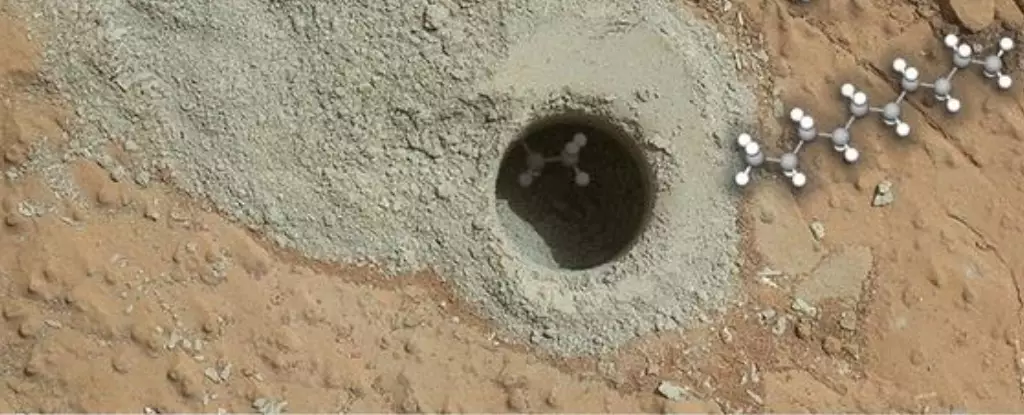The thrilling idea of finding life beyond Earth has captured human imagination for centuries. Recent developments arising from NASA’s Curiosity rover, however, redirect this dream into the realm of tantalizing discovery. Researchers have identified chains of carbon atoms, with lengths reaching up to a dozen, from sediment samples obtained from what is believed to be an ancient lakebed on Mars. This groundbreaking finding transcends mere scientific interest; it represents a potential turning point in our quest to understand life’s existence beyond our planet. Led by the analytical chemist Caroline Freissinet of the French National Centre for Scientific Research (CNRS), this research epitomizes the collaborative spirit of international science aimed at peeling back the layers of Martian history.
Avenues of Inquiry into Mars’ Past
The existence of these organic compounds encapsulates a wealth of implications. Significantly, while the compounds could plausibly be produced through abiotic (non-living) processes, their mere presence is a promising sign that the Curiosity rover has succeeded where many presumed failure. In the vast panorama of Mars, the gallant rover traverses Gale crater’s sedimentary rocks, continuously sampling environments that hold clues to Mars’ distant past and its potential habitability. Each drilled hole into deposits like the Cumberland mudstone reveals signs of chlorinated and sulfur-containing organic matter, emphasizing the likelihood that more complex markers of life are strewn across the ancient Martian landscape.
Deciphering the Carbon Connection
Delving into these complicated samples required sophisticated techniques, where scientists harnessed an experimental approach to extract and enhance the chemical profile of these sediments. The temperatures soared as high as 850 °C (1,562 °F), delivering conditions conducive to the extraction of hydrocarbons during the analysis process. Among the findings were rare saturated hydrocarbon chains, particularly decane (C10H22), undecane (C11H24), and dodecane (C12H26)—the longest carbon chains identified on Mars to date. This is not merely an academic exercise; it underscores some of the most profound potentials for discovering life or the remnants of life forms that existed eons ago, deserving a serious academic celebration.
Biochemistry on Mars: A Real Possibility?
An essential point emerges from this research—while the presence of these carbon chains raises the question of how they formed, it also suggests that underlying biological processes could be at play. The research team notably pointed out that although these carbon chains could theoretically arise through abiotic means, they also bear an uncanny resemblance to the products of biochemical processes found within life forms on Earth. It’s a compelling argument that beckons further investigation into the intricacies of Martian history and biosignature potential.
Indeed, the researchers wisely caution against jumping to conclusions, noting that our earthly perspective can sometimes astray our interpretations of extraterrestrial findings. Each carbon compound analyzed could have alternative explanations; perhaps they were synthesized through processes unrelated to biological activity. Yet, one cannot help but consider the romantic allure of the possibility that life as we know it—albeit in a simpler form—once thrived on another planet.
The Future of Martian Exploration
What lies ahead in this brave new frontier? Although present technology allows us to scratch the surface of Martian chemistry, we are still deciphering whether we are on the verge of uncovering fossilized life or extant biological processes beneath the planet’s crust. Every sample collected contributes a piece to the puzzle, laying the groundwork for future missions that may involve more advanced robotics or even human exploration. Future efforts will undoubtedly build on current insights, propelled by the discoveries of dedicated teams who refuse to relinquish the hope of unlocking Mars’ mysteries.
In our relentless pursuit of understanding whether Earth is alone in the universe, each carbon chain becomes a symbol—a reflection of our unwavering curiosity and a reminder of our innate desire to explore the unknown. The narrative of life, whether dead or alive, may yet unfold, waiting for the day when we can hold tangible proof that life once flourished on our neighboring planet. Until such revelations materialize, each finding on Mars invites us to fantasize about the extraordinary possibilities that lie just beneath the surface, urging us onward in our quest for knowledge and understanding of life in the cosmos.


Leave a Reply